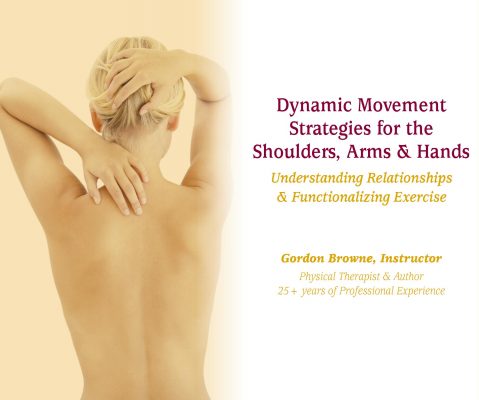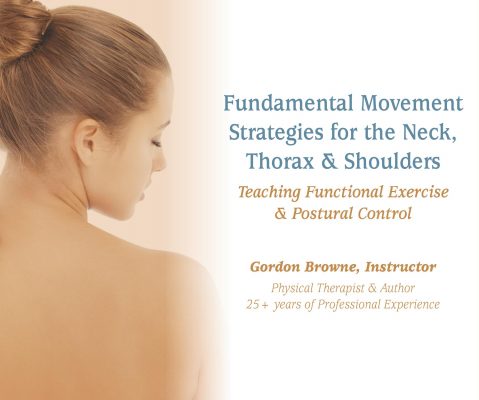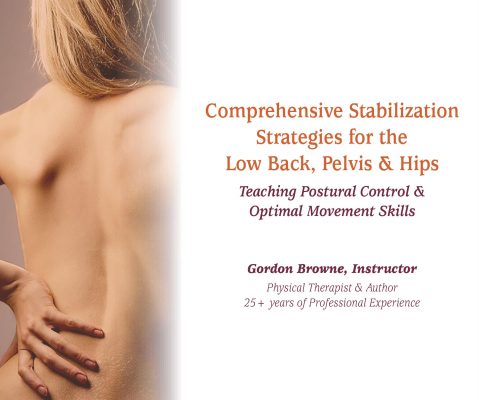Functional Movement Strategies for the
Legs, Knees & Feet
Understanding Relationships & Optimizing Exercise
16 Hours/CEUs
Course Description
With an emphasis on immediate clinical application to orthopedic knee, lower leg and foot dysfunction, this fun and interactive movement lab introduces ways of making the exercises we use more informative, more functional and much more effective. Discover how poorly organized movement in the hips and pelvis contributes to localized down-chain musculoskeletal pain, how to facilitate better patient motor planning and how movement changes in response to traumatic lower extremity injury. Gain a more dynamic perspective on human movement and be more creative in how you teach exercise, lower extremity alignment and function. Many knee, ankle and foot pain syndromes or repetitive stress injuries are a result of faulty lower extremity mechanics, while faulty mechanics will arise secondary to traumatic injury—both should be treated with an integrated exercise and proprioceptive self-awareness training program. In this course, you will participate in integrated movement exercises that focus on the relationships between feet, knees, hips and pelvis—then analyze the movements for clinical relevance and contrast with a traditional therapeutic movement model. This approach to studying movement (dynamic/alive vs anatomical/cadaveric) makes you a better practitioner by improving your fluency in the universal language of movement—proprioceptive awareness and choice-based motor habit optimization. Come experience a refreshing new perspective, you will never see movement and exercise the same way again!
Course Objectives
By the completion of this course, the participant will be able to:
- Define Regional Interdependence & Specificity Principle
- Identify long-term habitual movement and postural mistakes and correlate to plantar fasciitis, anterio/lateral ankle impingement, achilles tendinosis, anterior knee pain, ACL surgery, TKR, meniscal tear, hamstring strains and more
- List three primary differences between Static Integration & Dynamic Integration exercise
- Define the difference between Global & Differentiated movement or postural patterns—list two examples of each in the knee, ankle and foot
- List three principles of Optimal Movement and give examples of common knee and lower extremity clinical presentations resulting from sub-optimal movement
- Explain the benefits of informational exercise strategies—use of constraints, change of venue, reciprocating movements, goldilocks principle and link to functional context
Course Outline
Lab sessions include experiential movement, partner observations, facilitation techniques, modifications & discussion of clinical relevance.
Day 1
7:45-8:00—Registration & Snacks
8:00-9:45—Introduction to Integrated Movement
- Comparing Dynamic & Static Integration Movement Principles
- Language of Integrated Movement: Global & Differentiated Relationships
- Principles of Optimal Movement: Looking Beyond ROM & Strength
9:45-10:00—Morning Break
10:00-12:00—Lab I: Medial/Lateral Lower Extremity Relationships
- Asleep at the Wheel Syndrome: Repetitive Stress Injuries & Pattern Recognition
- Manual Facilitations: Peroneus Longus & Posterior Tibialis Awareness
- Rotational Knee/Foot Alignment & Stabilization: Movement Reciprocity & Pattern Specificity
12:00-1:00—Lunch on your own
1:00-3:00—Lab II: Anterior/Posterior Lower Extremity Relationships
- Simulating Push-Off: The Gluteal-Hamstring-Gastrocnemius Cascade
- Ankle/Toe Differentiations & Link to Hip Push Off Muscles: Shin Splints
- Knee Hyperextension Control: Manual Facilitations & Positional Progressions
3:00-3:15—Afternoon Break
3:15-5:30—Lab III: Finding & Maintaining the Tripod Foot
- Kinematic Linkage: Hip Control of Knee Valgus & Foot Pronation
- Hip Abductor/Peroneus Longus Synergy—Hip Adductor/Posterior Tibialis Synergy
- Knee Rotation Control: Manual Facilitations & Awakening the Hamstrings
Day 2
8:00-9:45—Lab IV: Pelvic Force Couple Competence & Balance
- Cross Pelvic Synergies: The Pelvic Force Couple
- Recognizing PFC Bias & Effects Down-Chain
- Alternating 3-Dimentional Hip Movements: Push Off & Landing
9:45-10:00—Morning Break
10:00-12:00—Lab V: Up/Down Stairs & Inclines
- Patellar Tracking & Compression Control
- Knee Valgus Control: The Goldilocks Principle & Introduction of Error
- Proportional Use of Synergists & Fascio-Skeletal Weight-Bearing
12:00-1:00—Lunch on your own
1:00-3:00—Lab VI: Medial/Lateral Knee & Ankle Stabilization
- Distal Stability & Proximal Mobility: Reversing Origin & Insertion
- Upping the Ante: Increasing Specificity, Complexity, Speed & Demand
- End-Game Rehab for Traumatic Injuries: Ankle/Knee Sprains, Fractures & Surgeries
3:00-3:15—Afternoon Break
3:15-5:00—Lab VII: Walking, Running, Pivoting & Cutting
- Drills, Progressions, Putting it All Together
- Proportional Use of Synergists: Hamstring, Hip Flexor & Adductor Strains/Tears
5:00-5:30—Wrap Up
- Review & Reinforcement of Course Objectives
- Research, Questions & Answers

Course Schedule:
April 27-28, 2024 -
Olympia, WA
Ramada Olympia
Ramada by Wyndham Olympia | Olympia, WA Hotels
Hotel Information Link
May 4-5, 2024 -
Sea-Tac, WA
Holiday Inn Express & Suites
Seattle Airport Hotel | Holiday Inn Express & Suites Seattle-Sea-Tac Airport
Hotel Information Link
May 18-19, 2024 -
Everett, WA
Hampton Inn
Hampton Inn Seattle/Everett, Washington Hotel
Hotel Information Link
State Approvals
We submit all our courses for continuing education approval in the state in which it is being held, if required. For more information please visit our State Approvals page
Registration Fee
| Single Registrant | $425 |
| 2 to 4* | $405 |
| 5 or more* | $370 |
*Price per person when registering at the same time. Please call if paying separately.
Brochure
Download the BrochureTestimonials
"Excellent, as always! You’re my first choice in con ed courses, you never disappoint!!"
"Great way of bringing awareness to stability of the legs and feet. It was awesome, thanks!"
"I really enjoyed this course, mostly lab vs sitting all weekend! Outstanding information and excellent instructors."
"Great content and love the course videos. Looking forward to taking all of your courses!"
"Plenty of hands on active learning, great explanations and complimentary to my practice. Loved it!"
"I had a great time and learned lots!! I’m moving so much better it’s amazing. Thank you so much!"
"Gordon and Julie are a great team! They complement one another and create the perfect learning environment."
"Great content both personally and professionally, what a bonus!"
"A really fun course packed with great information, very creative!"
"Great presentation, Gordon made learning this stuff fun!"
 Gordon Browne, PT
Gordon Browne, PT


